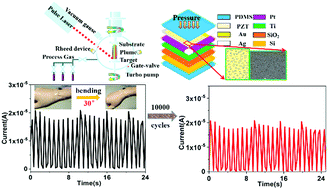A Flexible e-skin based on micro-structured PZT thin films prepared via a low-temperature PLD method†
Abstract
The e-skin based on lead zirconate titanate (PZT) exhibits excellent electrical sensing performance, and it is widely used in clinical trials owing to its prominent piezoelectric, ferroelectric and pyroelectric performance. However, the complicated fabrication procedure and fatigue during long-term use still limit its application. In this study, a flexible e-skin withstanding fatigue over extended periods of use (more than 10 000 cycles) was facilely constructed by combining polydimethylsiloxane (PDMS) with a highly crystalline PZT thin film. Note that the sensor was first fabricated using the micro-structured PZT thin film via a low-temperature pulsed laser deposition system (PLD) method, which could be easily combined with other processes. The sensor highlighted an ultra-high detection sensitivity (S, ∼5.82 kPa−1) and almost negligible hysteresis rate or degree of hysteresis (DH, ∼0.45%) in the pressure-sensing test. Moreover, the obtained sensor exhibited the lower limit of detection (LOD) of 30 Pa as well as a faster response (∼0.38 s) and release time (∼0.79 s). Importantly, due to the excellent performance of this sensor, various dynamic and static signals of the human body could be detected within the maximum range allowed under the septal fracture effect.



 Please wait while we load your content...
Please wait while we load your content...